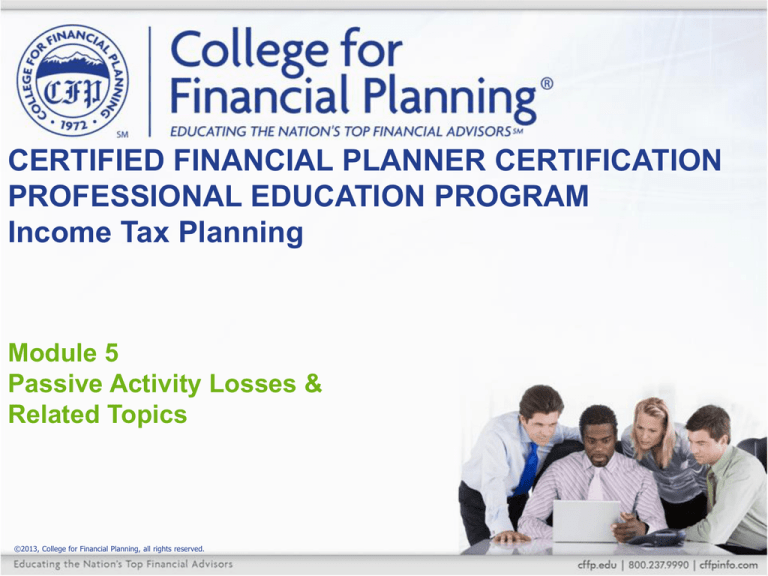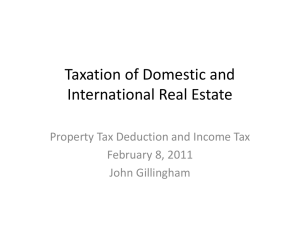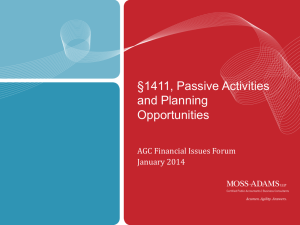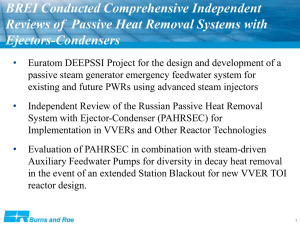
CERTIFIED FINANCIAL PLANNER CERTIFICATION
PROFESSIONAL EDUCATION PROGRAM
Income Tax Planning
Module 5
Passive Activity Losses &
Related Topics
©2013, College for Financial Planning, all rights reserved.
Learning Objectives
5–1: Identify legal forms or structures a direct participation program
may use and the tax and nontax considerations in selecting a
form.
5–2: Identify tax mechanisms that enable direct participation programs
to provide specific tax advantages.
5–3: Identify factors that may limit the availability of federal income
tax benefits from a direct participation program.
5–4: Identify rules, deductions, or benefits related to a direct
participation program.
5–5: Identify requirements that must be met to qualify for a special
tax benefit available from a direct participation program.
5–6: Evaluate a situation to select the most appropriate direct
participation program, if any.
5–7: Analyze a situation to calculate the allowable deductions under
the passive activity loss rules.
5–8: Identify rules related to a vacation, or second, residence.
5–9: Analyze a situation to calculate the allowable deductions under
the vacation home rules.
5-2
Questions to Get Us Warmed Up
5-3
Learning Objectives
5–1: Identify legal forms or structures a direct participation program
may use and the tax and nontax considerations in selecting a
form.
5–2: Identify tax mechanisms that enable direct participation programs
to provide specific tax advantages.
5–3: Identify factors that may limit the availability of federal income
tax benefits from a direct participation program.
5–4: Identify rules, deductions, or benefits related to a direct
participation program.
5–5: Identify requirements that must be met to qualify for a special
tax benefit available from a direct participation program.
5–6: Evaluate a situation to select the most appropriate direct
participation program, if any.
5–7: Analyze a situation to calculate the allowable deductions under
the passive activity loss rules.
5–8: Identify rules related to a vacation, or second, residence.
5–9: Analyze a situation to calculate the allowable deductions under
the vacation home rules.
5-4
Direct Participation Programs (DPP)
Advantages
Disadvantages
Limited
Partnership
General
Partnership
Limited liability
Management control
Flexible size
Simple to form
Illiquidity
No management voice
for limited partners
Personal liability
Small size
DPP is simply a conduit entity.
5-5
Direct Participation Programs (DPP)
Advantages
Disadvantages
Master Limited
Partnership
Direct Ownership
Limited liability
Easy to do
High liquidity
High level of control
Many MLPs treated as
corporations (not DPP)
Personal liability
Publicly-traded
partnership rules
Inflexible, illiquid
5-6
Direct Participation Programs (DPP)
S Corporation
Advantages
Disadvantages
Limited liability
Some voice in management
Use limited in situations in which S
corporation requirements can be met
Income taxed to shareholder even if it is
retained by the corporation
5-7
Tax Mechanisms
Tax Conduit
• Income flows through without “double taxation”
• Losses flow through and may be used to offset other income
(subject to limits)
Special Allocation
• Income and losses need not be allocated pro rata, but can be used
in a way that provides the greatest tax benefit (subject to
substantial economic effect rules)
Accelerated Deductions
• Accelerated “noncash” deductions may result in a net loss for tax
purposes, even though there is positive cash flow
Tax Credits
• Allowed credits flow through to reduce individual tax liability
(subject to passive activity loss and credit limits)
Leverage (borrowing)
• May be used to magnify tax impacts (subject to at-risk rules)
5-8
Tax-Advantaged Investment
Factors Limiting Effectiveness of a Tax-Advantaged
Investment
• Limitation on Losses and Credits from Passive
•
•
•
Activities: Limits a taxpayer’s ability to use losses or
credits to reduce the tax due on active or portfolio
income
Substantial Economic Effect: Limits the use of
special allocations
At-Risk Rules: Limit the use of leverage—not as risk
for nonrecourse financing—generally
Alternative Minimum Tax (AMT): Limits a taxpayer’s
ability to reduce overall tax liability by imposing a tax on
alternative minimum taxable income, which includes
preference items and adjustments
5-9
Factors to Consider
• Need for Liquidity: Many direct participation programs lack
•
•
•
•
liquidity; Master limited partnerships are an exception
Need to Preserve Capital: Many direct participation
programs involve significant risk
Unused Passive Losses: need passive income generators
(PIGs): Direct participation programs that generate passive
income are most suitable for those who have unused passive
losses
Low Marginal Income Tax Bracket: Clients in a low
income tax bracket derive the least advantage from taxadvantaged investments
Alternative Minimum Tax Problems: Investment in direct
participation programs may cause even greater alternative
minimum tax problems
5-10
Learning Objectives
5–1: Identify legal forms or structures a direct participation program
may use and the tax and nontax considerations in selecting a
form.
5–2: Identify tax mechanisms that enable direct participation programs
to provide specific tax advantages.
5–3: Identify factors that may limit the availability of federal income
tax benefits from a direct participation program.
5–4: Identify rules, deductions, or benefits related to a direct
participation program.
5–5: Identify requirements that must be met to qualify for a special
tax benefit available from a direct participation program.
5–6: Evaluate a situation to select the most appropriate direct
participation program, if any.
5–7: Analyze a situation to calculate the allowable deductions under
the passive activity loss rules.
5–8: Identify rules related to a vacation, or second, residence.
5–9: Analyze a situation to calculate the allowable deductions under
the vacation home rules.
5-11
Passive Activities
• Trade or business activity without material
•
participation
(or)
All rental activities except:
o Hotel/motels
o Rental activities with significant services
provided
o Short-term rentals of property
(DVDs, tuxedos, etc.)
o Material participation in real property trades
or businesses
o Active participation in rental real estate
5-12
Material Participation
• Meets one of seven tests under regulations
o 500 hours per year of participation—most
common test
o 100 hours and no one participates more
o Facts and circumstances test
• Regular, continuous, and substantial involvement
• What is taxpayer’s knowledge, background,
experience?
5-13
PAL Exceptions/Opportunities
Active Participation in Rental Real Estate
•
•
•
•
•
•
Requires “bona fide” involvement
$25,000 of losses allowed annually
$100,000 to $150,000 AGI phaseout of losses
10% or greater ownership interest in the
activity
Not a limited partnership interest
Not available if MFS, unless lived apart for
entire year
5-14
PAL Exceptions/Opportunities
Historic Rehabilitation Programs
• $25,000 deduction-equivalent tax credit
• May offset tax due on up to $25,000 of other
income
• $200,000 to $250,000 AGI phaseout
5-15
PAL Exceptions/Opportunities
Low-Income Housing Activity
• $25,000 deduction-equivalent tax credit
• May offset tax due on up to $25,000 of other
income
• $200,000 to $250,000 AGI phaseout if
property placed in service prior to 1990
• No AGI limit if property placed in service
after 1989
5-16
PAL Exceptions/Opportunities
Ownership of Oil and Gas Working Interest
• Losses are deemed to be not passive.
• The form of ownership cannot limit taxpayer’s
•
•
personal liability.
No participation is required.
Losses are deductible without limit and without
respect to taxpayer’s AGI.
Investments that Generate Passive Income
• Passive income may be offset by passive losses.
• Taxpayers with otherwise unused passive losses may
receive passive income essentially tax free.
5-17
Requirements to Qualify for Special Tax Benefits
Closely Held C Corporation
• If not a personal service corporation, passive losses may
be used to offset active income, but not portfolio income.
Qualified Nonrecourse Financing
• secured by the real property
• no one is personally liable
• not convertible into equity
• provided either by:
o an unrelated entity in the business of lending money,
or
o a related person on commercially reasonable terms
5-18
Material Participation in Real Estate
Losses deductible if
• more than 50% of hours are devoted to real
property trades or businesses with material
participation
• more than 750 hours are in real property
trades or businesses with material
participation
5-19
Publicly Traded Partnerships
• Losses are not deductible
•
•
against other passive income.
Losses are held in suspense
until SAME activity generates
income.
Income cannot be offset by
passive losses arising from any
other source.
5-20
Disposition Rules
Sale/Exchange
• All losses are ‘freed up’ and deductible in full
against other income if disposition of
“substantially all.”
Death
• Losses are deductible to the extent that the
losses exceed step-up in basis
of activity.
Gift
• Losses are added to basis of
gifted activity.
5-21
Learning Objectives
5–1: Identify legal forms or structures a direct participation program
may use and the tax and nontax considerations in selecting a
form.
5–2: Identify tax mechanisms that enable direct participation programs
to provide specific tax advantages.
5–3: Identify factors that may limit the availability of federal income
tax benefits from a direct participation program.
5–4: Identify rules, deductions, or benefits related to a direct
participation program.
5–5: Identify requirements that must be met to qualify for a special
tax benefit available from a direct participation program.
5–6: Evaluate a situation to select the most appropriate direct
participation program, if any.
5–7: Analyze a situation to calculate the allowable deductions under
the passive activity loss rules.
5–8: Identify rules related to a vacation, or second, residence.
5–9: Analyze a situation to calculate the allowable deductions under
the vacation home rules.
5-22
Vacation Home Rules
Residence Test
• if met, no losses allowed
• deduction allowed to extent income exceeds interest
and taxes
Infrequent Rentals (14 days or less),
Frequent Personal Use
• rental income not reported
• interest and taxes allowed as itemized deductions
• no other rental deductions
5-23
Vacation Home Rules
Frequent Rentals (more than 14 days)
Infrequent Personal Use
• losses allowed
• property tax attributable to personal use is
itemized deduction
• mortgage interest attributable to personal
use is treated as investment interest expense
5-24
Vacation Home Rules
Frequent Rentals (more than 14 days)
Frequent Personal Use
• no loss allowed
• excess deductions are carried forward
• interest and property taxes attributable to
personal use are allowed as itemized
deductions
5-25
Review Question 1
Which one of the following is a disadvantage of
the limited partnership form of doing business?
a. The limited partner has no voice in
management.
b. Interests are excessively liquid, creating
volatile swings in value.
c. The number of limited partners is restricted
to 100.
5-26
Review Question 2
A special allocation typically results in
a. the partner in the lowest tax bracket
receiving more deductions.
b. an allocation of gains and losses based upon
the ownership percentage of the partner.
c. an allocation of income and deductions that
differs from the partner’s share of bottomline profits and losses.
5-27
Review Question 3
Which one of the following is not an item used
in determining the amount a partner has at
risk?
a. the adjusted basis of property contributed to
the partnership
b. amounts borrowed for use in the activity for
which the partner is personally liable for
repayment
c. amounts borrowed for use in the activity
that were secured only by the investment
5-28
Review Question 4
Qualified nonrecourse financing is financing
a. that is convertible into an equity interest.
b. for which the partners are personally liable.
c. that is secured by the real property.
5-29
Review Question 5
The passive activity loss rules apply to
a. personal service corporations only.
b. closely held C corporations only.
c. individuals only.
d. personal service corporations, closely held
C corporations, and individuals.
5-30
Review Question 6
Which of the following describes a requirement for a
taxpayer to be considered a real estate professional under
the passive activity rules?
a. The individual performs more than 750 hours of service
during the year in the real property trades or businesses
in which the individual materially participates.
b. More than 75% of the individual’s personal services
during the year are performed in the real property trades
or businesses in which the individual materially
participates.
c. The individual performs more than 1,000 hours of service
during the year in all real property trades or businesses,
regardless of the individual’s level of participation.
5-31
Review Question 7
Which one of the following is a characteristic of
the historic rehabilitation tax credit?
a. The credit may be used to offset up to
$25,000 in income tax.
b. The credit may be used to offset the tax on
up to $25,000 in income.
c. The credit is phased out on adjusted gross
income between $100,000 and $150,000.
d. The credit is phased out on taxable income
between $200,000 and $250,000.
5-32
Review Question 8
Which one of the following is a characteristic of the
rules related to publicly traded partnerships?
a. Losses from publicly traded limited partnerships
may be used only to offset income from other
publicly traded limited partnerships.
b. Unused losses from publicly traded limited
partnerships may be carried back up to three
years to offset prior income from such
partnerships.
c. Unused losses from publicly traded limited
partnerships must be carried forward and used
only against future income of the same
partnership.
5-33
Review Question 9
An individual will generally be treated as a
material participant in an activity if
a. he or she participates less than 100 hours in
the activity.
b. he or she participates more than 500 hours
in the activity.
c. another individual performs substantially all
of the services associated with the business.
5-34
Review Question 10
Which one of the following statements is true
regarding a vacation home (second residence)?
a. Net income from the rental of a vacation
home is considered to be passive.
b. Expenses are allocated between personal
and rental use if the unit is rented out fewer
than 15 days per year.
c. Personal use of the residence does not
include a day on which the taxpayer
engages in repairs of the unit on a full-time
basis.
5-35
Review Question 11
Which one of the following describes the treatment
of a vacation home that is frequently rented and
infrequently used by the owner?
a. Deductions are permitted for all of the
maintenance and operating expenses, as long
as personal use does not exceed 14 days.
b. Deductible rental expenses are not limited to
gross rental income.
c. Unused mortgage interest and property taxes
may be carried over to the subsequent year and
used against future income from the rental
activity.
5-36
Review Question 12
Which one of the following statements is correct as it
applies to a vacation home with frequent personal use
and frequent rentals?
a. Any excess deductions attributable to rental use may
be carried forward and applied against future rental
income.
b. the tax court method of allocation allocates
mortgage interest and property taxes based upon a
comparison of the number of days that the property
is rented at fair value to the total number of days
the property is used during the year.
c. Deductions allocable to rental use are not limited to
gross income.
5-37
Review Question 13
Your client, Marian Powers, has substantial unused
passive losses from a nonpublicly traded limited
partnership. She would like to find an investment that
would allow her to utilize her passive losses.
Which one of the following is the most appropriate
investment for Marian?
a. a master limited partnership generating income
b. certificates of deposit generating portfolio income
c. a publicly traded limited partnership generating
income
d. a nonpublicly traded partnership generating income,
in which Marian will not materially participate
5-38
Review Question 14
Sally Franklin has AGI of $300,000. In addition, she currently has
passive income of $150,000 and passive losses of $175,000;
$150,000 of which she uses to offset the passive income and
$25,000 of which is subject to disallowance.
Which one of the following activities, if any, has the greatest
potential for reducing Sally’s tax liability?
a. investing in “active participation” rental real estate that is
producing a loss
b. investing in a low income housing activity placed in service
after 1989 that is producing deduction-equivalent credits
c. investing in a limited partnership involved in a historic
rehabilitation project that is producing passive losses and
credits
d. investing in an oil and gas limited partnership that is
generating losses
5-39
Review Question 15
Paul Hall has the following items from the current year:
income from ABC
$10,000
(a publicly traded limited partnership)
loss from DEF
(a publicly traded limited partnership)
income from RST
(a nonpublicly traded limited partnership)
$11,000
$13,000
loss from XYZ
$19,000
(a nonpublicly traded limited partnership)
What is the total amount, if any, of passive losses that may be
deducted during the current year?
a. $0
b. $13,000
c. $23,000
d. $29,000
e. $30,000
5-40
Review Question 16
Which of the following statements are correct with
respect to active participation rental real estate?
I. The interest may not be held through a limited
partnership.
II. A deduction-equivalent tax credit of up to $25,000
is available.
III. The taxpayer must hold a 10% or greater
ownership interest.
IV. The taxpayer must participate in the management
of the property in a bona fide sense.
a.
b.
c.
d.
e.
I and II only
I and IV only
III and IV only
I, II, and III only
I, III, and IV only
5-41
CERTIFIED FINANCIAL PLANNER CERTIFICATION
PROFESSIONAL EDUCATION PROGRAM
Income Tax Planning
Module 5
End of Slides
©2013, College for Financial Planning, all rights reserved.








